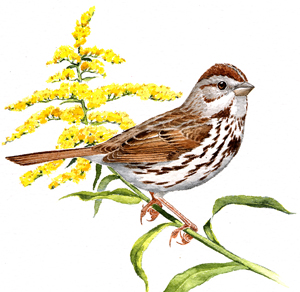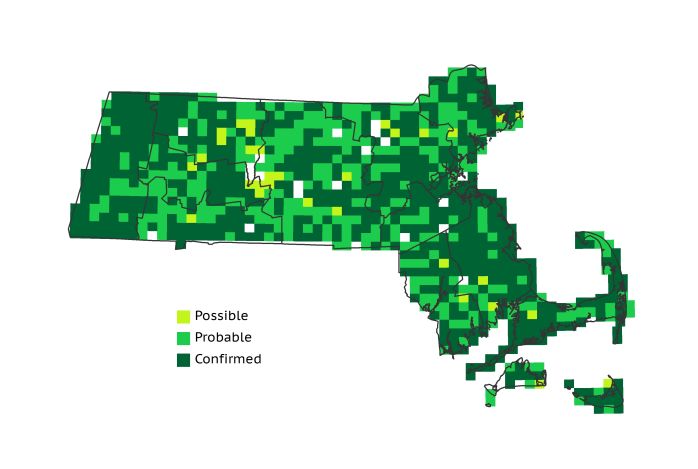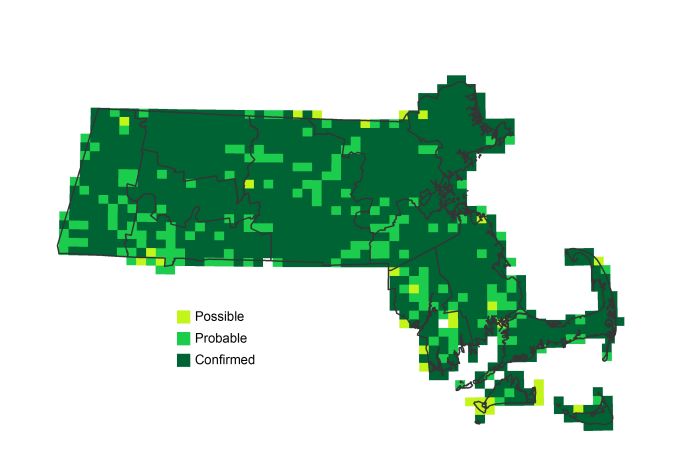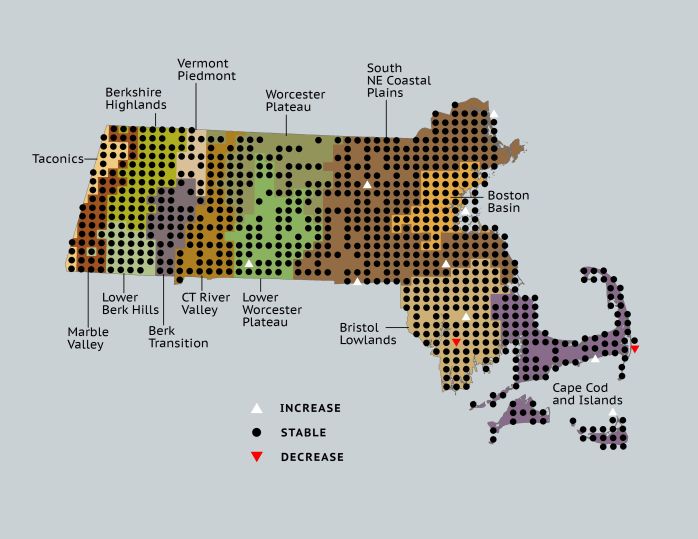Find a Bird
Song Sparrow
Melospiza melodia

Nearly ubiquitous and stable
Action/monitoring needed
“A bird doesn’t sing because it has an answer, it sings because it has a song.” – Maya Angelou
The Song Sparrow, found in more blocks than any other species in both Atlas 1 and Atlas 2, is a welcome visitor to fields, farms, parks, and gardens throughout Massachusetts. One of the first birds that many novice birders learn to identify by sound, the aptly named Song Sparrow may be heard singing its bright and cheery song from sunup to sundown from spring to fall. While many sparrow species are struggling to maintain their numbers, the irrepressible Song Sparrow seems to be holding its own. Its ready use of almost any open or semi-open habitat has helped the species remain practically ubiquitous even in the face of suburbanization and other major landscape changes. Like the Savannah Sparrow, this species has a massive North American breeding range, and that adaptability has likely served the Song Sparrow well over time.
Historic Status
The Song Sparrow has been a summer resident in Massachusetts at least since the days of John James Audubon. “The Song Sparrow, Fringilla melodia, is a well-known bird, very common in all parts of New England…” wrote William Peabody (Peabody 1839), and sixty years later Howe & Allen still described the species as “a very common summer resident,” (Howe & Allen 1901). Its ability to breed in many different habitats made it nearly ubiquitous across the state, and the only question about its future rested in the length of its annual stay in Massachusetts. As the nineteenth century wore on, observers increasingly noted the occasional Song Sparrow wintering in Massachusetts (Howe & Allen 1901).
Atlas 1 Distribution
The Atlas 1 distribution map for the Song Sparrow provides an object lesson in Atlas coverage as well as a guide to the bird’s distribution. A combination of broad habitat requirements, tolerance for human presence, and an easily recognized song led to Song Sparrows being found in almost every block that was adequately surveyed during Atlas 1. Where Song Sparrows were not present in 100% of a region’s blocks, they were often missing in only 2 or 3. The Lower Worcester Plateau and Coastal Plains each had a small scattering of unoccupied blocks; but otherwise the species was widely present throughout every region from the Berkshires to Nantucket.
Atlas 2 Distribution and Change
In Atlas 2, just as in Atlas 1, the Song Sparrow took home the title of most widely distributed bird in Massachusetts. Even with little room for growth, the species still managed to expand, disappearing from only a few blocks and colonizing a few more. Perhaps more interestingly, Atlas workers Confirmed breeding records in 79% of the state as compared to just 61% in Atlas 1. The fact is more remarkable when one considers that people working in Atlas 1 had no seasonal constraints and no Safe Dates to work with, while Atlas 2 workers had both Safe Dates and a mandate to complete a set number of hours.
Atlas 1 Map

Atlas 2 Map

Atlas Change Map

Ecoregion Data
Atlas 1 | Atlas 2 | Change | ||||||
Ecoregion | # Blocks | % Blocks | % of Range | # Blocks | % Blocks | % of Range | Change in # Blocks | Change in % Blocks |
Taconic Mountains | 16 | 100.0 | 1.7 | 21 | 84.0 | 2.1 | 0 | 0.0 |
Marble Valleys/Housatonic Valley | 39 | 100.0 | 4.2 | 39 | 100.0 | 3.8 | 0 | 0.0 |
Berkshire Highlands | 55 | 100.0 | 5.9 | 55 | 100.0 | 5.4 | 0 | 0.0 |
Lower Berkshire Hills | 27 | 96.4 | 2.9 | 30 | 96.8 | 2.9 | 0 | 0.0 |
Vermont Piedmont | 16 | 94.1 | 1.7 | 17 | 100.0 | 1.7 | 0 | 0.0 |
Berkshire Transition | 38 | 100.0 | 4.0 | 40 | 100.0 | 3.9 | 0 | 0.0 |
Connecticut River Valley | 56 | 100.0 | 6.0 | 65 | 100.0 | 6.4 | 0 | 0.0 |
Worcester Plateau | 76 | 97.4 | 8.1 | 88 | 100.0 | 8.6 | 0 | 0.0 |
Lower Worcester Plateau | 69 | 93.2 | 7.3 | 79 | 98.8 | 7.7 | 1 | 1.9 |
S. New England Coastal Plains and Hills | 259 | 95.9 | 27.6 | 281 | 99.3 | 27.5 | 4 | 1.8 |
Boston Basin | 55 | 98.2 | 5.9 | 56 | 100.0 | 5.5 | 1 | 1.8 |
Bristol and Narragansett Lowlands | 104 | 98.1 | 11.1 | 112 | 98.2 | 11.0 | 0 | 0.0 |
Cape Cod and Islands | 129 | 94.9 | 13.7 | 139 | 96.5 | 13.6 | 1 | 0.8 |
Statewide Total | 939 | 96.9 | 100.0 | 1022 | 98.6 | 100.0 | 7 | 0.8 |
Notes
Despite this apparent stability in breeding footprint, the Breeding Bird Survey (BBS) shows significant declines in abundance for Massachusetts, the New England/Mid-Atlantic Region, and the Eastern US overall for the Song Sparrow. It falls into our “whispering bird” category – those species with a demonstrated stable or increasing breeding footprint from Atlas 2 data, but also a demonstrated decline in abundance from the BBS. This drives our final assessment that this is a species with a need for further monitoring and conservation action.



